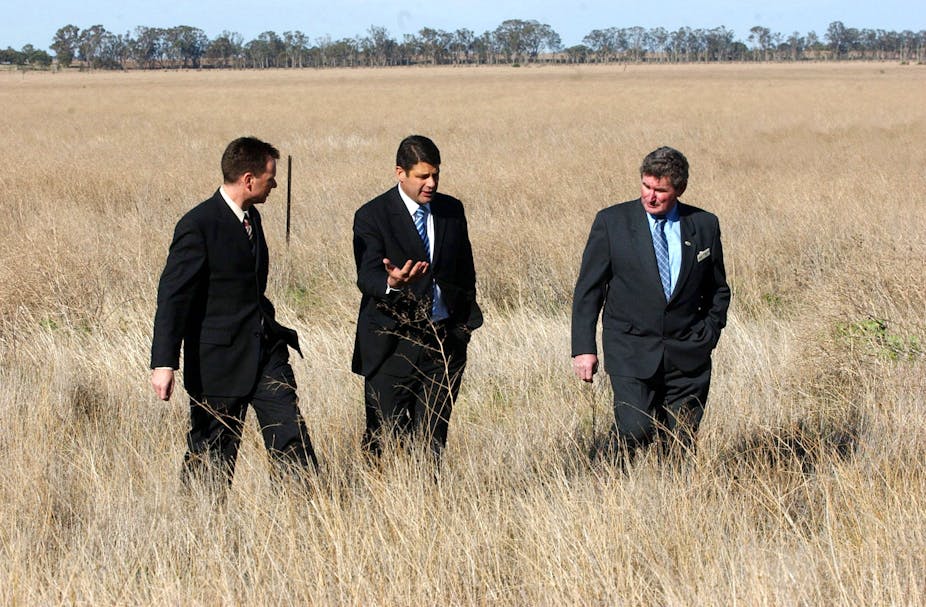The notion that Australia is the driest inhabited continent on the planet has created a persistent stereotype. Recent weather shows it to be misguided.
It suits embarrassed planners, myopic politicians and those peddling the next round of “drought-proofing” policies to point to the myth of the dry continent, but in reality Australia’s rainfall and water availability is highly variable.
The challenge we face is not just dealing with drought, but how to handle enormous fluctuations in water availability and to cater for the risks and uncertainties involved.
Victoria provides a good example of how variability can prove troublesome for the institutions we have created to manage the supply of water. As John Quiggin succinctly put it “the policies of the Victorian government have been more consistent [than the Commonwealth]. Unfortunately, however, they have been consistently misguided”.
Victoria’s governance systems do not have the adaptability that’s required to manage variable water supplies. Climate change is likely to further expose their deficiencies.
One of the peculiar features of Victoria’s irrigation sector was that much of it grew to favour perennial activities, like horticulture and dairying. This is partly due to the type of entitlement and allocation system that was developed.
Specifically, Victoria managed the water it held in storage relatively conservatively – banking next year’s water before accessing this year’s.
That conservatism worked well in terms of providing a sense of security about water. But shoring up water counts for little when the produce has to be sold at a loss. The significant contraction in the number of dairy farms witnessed in northern Victoria, even during wet years, is evidence of the critical importance of output prices – not that water planners pay much attention to this.
Nonetheless, the commitment to perennial agriculture on the basis of valuable but ill-defined “flow-on” benefits to communities lingers today. Routine announcements about the so-called “value” of these sectors to the Victorian economy are used to rationalise immodest calls on the public purse during times of water shortage – or to sponsor foolhardy development in times of plenty.
On the urban front, the focus has been justifiably directed at Melbourne’s water demands and the impacts of a growing population. Regional communities still face problems when water becomes scarce, but these are usually subsumed by the policy options selected for Melburnians.
When the last drought occurred the then Labor government followed a two-fold approach that was similar to those used in other jurisdictions. This involved water restrictions and expansive advertising campaigns – dressed up as “education” – that were designed to demonise outdoor water use.
The second element of the policy approach was a swathe of infrastructure projects, hastily brought forward to augment supply and ease public worries Melbourne would run out of water.
An inconvenience for the Victorian government at that time was the national commitment to ensure that any water infrastructure projects passed a basic benefit-cost test. When some of these projects proved difficult to justify, various forms of voodoo economics were invoked.
The upshot is that Melbourne now has an expensive desalination plant, a pipeline joining urban water supplies to comparatively low-value agriculture in the north, and a community with some segments that are passionate about water-saving at almost any economic or social cost.
So how well will Victoria cope with the next drought?
As witnessed with the previous drought, the most successful coping strategies are tied to a decision makers’ capacity to be flexible to differing levels of water availability as new information emerges over time. It does not pay to guess too far into the future about the length or severity of drought, and over-reliance on historical data can make decision makers look foolish.
Economists sometimes call this a “no regrets” approach – choosing approaches that make good sense now, but not rushing ahead such that options close off too quickly or involve heavy and potentially unnecessary costs in the future.
An example of this approach is the current physical interconnection between Melbourne and agricultural water supplies in the north of the state. If used appropriately with water markets, this type of infrastructure has much to offer for Melburnians, farmers and environmental interests.
For example, a variety of market instruments can be used to distribute the risks and consequences of drought, ensuring that those who can afford to go without are well-rewarded, while those who need it can continue to have access to the resource.
In the last drought, dairy farmers used the market to sell water rights, employing the proceeds to stay in business. The purchasers of water, often horticulturalists, were also able to continue to produce in spite of the severity of the conditions.
However, this trade was restricted to agriculturalists – politicians get nervous about water traded to cities and the environment.
This is unfortunate, as to get the most out of these types of markets, all water users should be in the market. Higher diversity of users leads to more innovative trades.
Unfortunately, the Victorian government has shown no appetite for this kind of change. One of the first actions of the current Minister for Water, Peter Walsh, was to place a drought threshold on the use of the north-south pipeline that virtually takes it out of the market equation for Melburnians.
Less publicised were the immediate costs to Melburnians, and the flow-on consequences for farmers, who in the longer term could sell their water or use options contracts to cushion their businesses against drought.
The Victorian government’s rationale for restricting trade is apparent concern for the parties involved. But this misplaced nervousness about trading water assumes that the government knows when the next drought will occur, how long it will last and the cheapest way to see it through.
By almost any measure, the evidence does not support this idealistic view of government. It does not bode well for a flexible approach to drought in the future.

